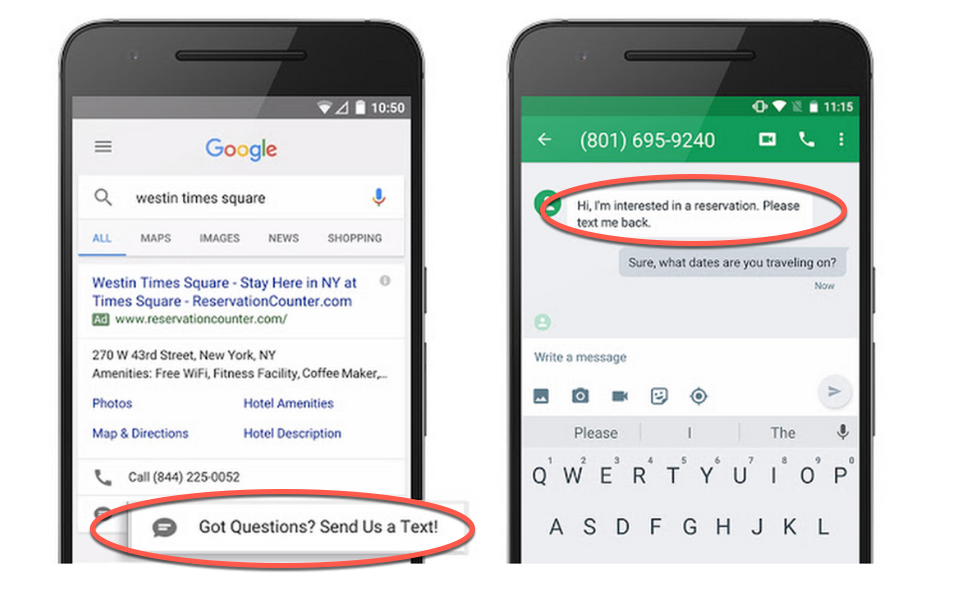Google Ads message extensions were rolled out in October 2016 without a lot of fanfare.
At the time, we assessed which of our clients would be a good fit for this kind of extension and approached those clients to see if they’d be willing to give message extensions a try.
But many of them resisted – often with legitimate concerns.
More recently, however, we’re taking another look at message extensions.
Some additional features and options have been added since their initial rollout, making them more flexible and appealing.
Still, I expect to hear many of the same objections.
Therefore, I will use this article to review what message extensions are and address the most common concerns we hear.
What Are Google Ads Message Extensions?
Message extensions allow customers to message you directly from your Google ad.
Customers simply have to click on the call to action, such as “Send us a text” or “Message us for help.”
Then, customers are taken to their messaging app where they can send you a text message.
You can even pre-populate the initial message for customers, such as “Tell me more about your offer” or “I’d like to make a reservation.”
Here’s an example of a message extension (on the left) and a pre-populated message in a messaging app (on the right):

Once you receive the message, someone on your team can respond.
You can add message extensions to your account at the account, campaign or ad group levels, just as with other extensions.
And as with most other extensions, you’re charged whenever someone clicks the messaging extension on your ad.
Now that we’ve reviewed what message extensions are, let’s take a closer look at some of the objections we hear about them.
1. ‘I Don’t Have Staff to Monitor Messaging 24/7’
Allowing customers to message you directly from your ads can sound daunting.
After all, not every company has the capability to monitor and respond to text messages 24/7.
The good news is that you don’t have to.
Just as with call extensions, you can set up message extensions so that they only display during your opening hours – when you have staff available to receive text messages and respond.
You can also add start and end dates and create different schedules for specific days.
As of October 2018, you also have the additional options of using email forwarding and automatic replies.
With email forwarding, customer texts go to your email inbox instead of your SMS service, which (depending on your organization) might make it easier to manage and respond.
It also means you no longer have to have a phone number that can receive text messages to use this extension.
There are some limits to email forwarding, however. It’s only available in the U.S., Canada, Brazil, and Australia – and it only works with Gmail, Outlook and Yahoo email addresses.
With automatic replies, you can set up messages to automatically respond to texts you receive from your ads.
For example, you can have an automated message that says, “Thanks for your message. We’ll get back to you within two hours.” This can help set expectations about how long it will take you to respond.
2. ‘My Customers Won’t Use Them’
Just like every other ad extension, message extensions aren’t a great fit for everyone.
You have to consider your target market, their preferences, and how comfortable they are with technology.
If your target market aren’t big mobile users, for example, you might not get much activity.
Even worse, your customers might get confused and start clicking randomly – resulting in a lot of wasted clicks.
Still, according to a 2016 Google Consumer Survey, nearly two-thirds of smartphone owners use messaging more than five times a day to communicate with others. Today, this percentage must be even greater.
If your target market are heavy mobile users, then this ad extension might be an excellent fit.
3. ‘They’re Hard to Measure’
OK, this isn’t really an objection we hear from our clients, but it’s something that we used to think.
When message extensions were initially rolled out, they were almost impossible to track and measure.
But since then, the situation has improved somewhat.
Now, you can define how many message exchanges must occur before it counts as a conversion.
For example, say someone wants to make a hotel reservation. You’ve studied past message exchanges and you know that it typically takes at least three messages for a reservation to be made.
Therefore, you can set three messages as your threshold for the exchange to count as a conversion.
This isn’t a perfect measuring method of course. But it’s still better than what we had before (which was nothing).
Is It Time to Give Message Extensions Another Try?
Given the changes in message extensions – and the further growth in mobile and messaging use – it might be time to give message extensions another try.
You might find that they’re an excellent fit for your business.
More Resources:
- Everything You Need to Know About Ad Extensions
- A Guide to Every Automated Google Ad Type
- Google Enhances Click-to-Message Ads With Email Forwarding and Auto Replies
Image Credits
Feature Image: Dreamstime.com
Message Extensions Image: ©2019 Google LLC, used with permission. Google and the Google logo are registered trademarks of Google LLC





